接上一篇文章
上一篇讲到了doGetTransaction方法

一、模板方法设计模式
这里涉及到了一个经典的设计模式:模板方法
如下图:
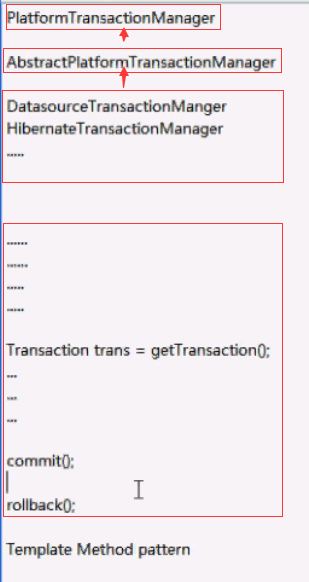
AbstractPlatformTransactionManager实现了PlatformTranscationManager接口
DatasourceTransactionManager,HibernateTransactionManager等继承了AbstractPlatformTransactionManager类
AbstractPlatformTransactionManager类中定义了事务处理的若干方法。 其中获得事务,提交事务,回滚事务由具体的子类实现。
二、进入doGetTransaction的其中一个实现类Hibernate3中的HibernateTransactionManager 类
进入doGetTransaction方法
1 2 3 4 5 6 7 8 9 10 11 12 13 14 15 16 17 18 19 20 21 22 23 24 25 26 27 28 29 30 31 32 33 34 35 36 37 | @Overrideprotected Object doGetTransaction() { HibernateTransactionObject txObject = new HibernateTransactionObject(); txObject.setSavepointAllowed(isNestedTransactionAllowed()); SessionHolder sessionHolder = (SessionHolder) TransactionSynchronizationManager.getResource(getSessionFactory()); if (sessionHolder != null) { if (logger.isDebugEnabled()) { logger.debug("Found thread-bound Session [" + SessionFactoryUtils.toString(sessionHolder.getSession()) + "] for Hibernate transaction"); } txObject.setSessionHolder(sessionHolder); } else if (this.hibernateManagedSession) { try { Session session = getSessionFactory().getCurrentSession(); if (logger.isDebugEnabled()) { logger.debug("Found Hibernate-managed Session [" + SessionFactoryUtils.toString(session) + "] for Spring-managed transaction"); } txObject.setExistingSession(session); } catch (HibernateException ex) { throw new DataAccessResourceFailureException( "Could not obtain Hibernate-managed Session for Spring-managed transaction", ex); } } if (getDataSource() != null) { ConnectionHolder conHolder = (ConnectionHolder) TransactionSynchronizationManager.getResource(getDataSource()); txObject.setConnectionHolder(conHolder); } return txObject;} |
1、创建HibernateTransactionObject对象
1 | HibernateTransactionObject txObject = new HibernateTransactionObject();<br><br> |
1 | HibernateTransactionObject 是一个Hibernate事务对象,代表一个SessionHolder。被HibernateTransactionManger用作事务对象。 |

2、进入SessionHolder
SessionHolder: session持有者,包装了一个Hibernate Session和一个Hibernate事务
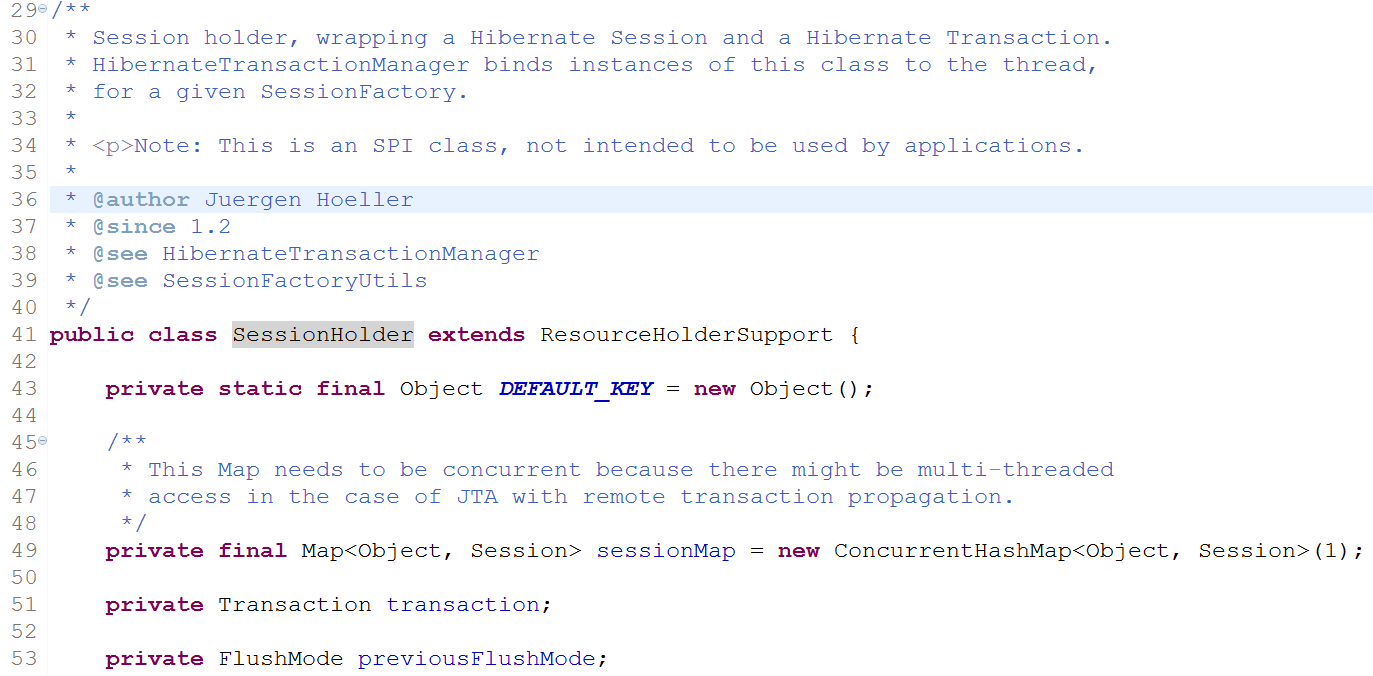
三 、进入doGetTransaction的其中一个实现类JDBC中的DataSourceTransactionManager 类
进入doGetTransaction方法
1 2 3 4 5 6 7 8 9 | @Overrideprotected Object doGetTransaction() { DataSourceTransactionObject txObject = new DataSourceTransactionObject(); txObject.setSavepointAllowed(isNestedTransactionAllowed()); ConnectionHolder conHolder = (ConnectionHolder) TransactionSynchronizationManager.getResource(this.dataSource); txObject.setConnectionHolder(conHolder, false); return txObject;} |
1 | 1、创建DataSourceTransactionObject实例 |
1 | DataSourceTransactionObject txObject = new DataSourceTransactionObject();<br>进入DataSourceTransactionObject |
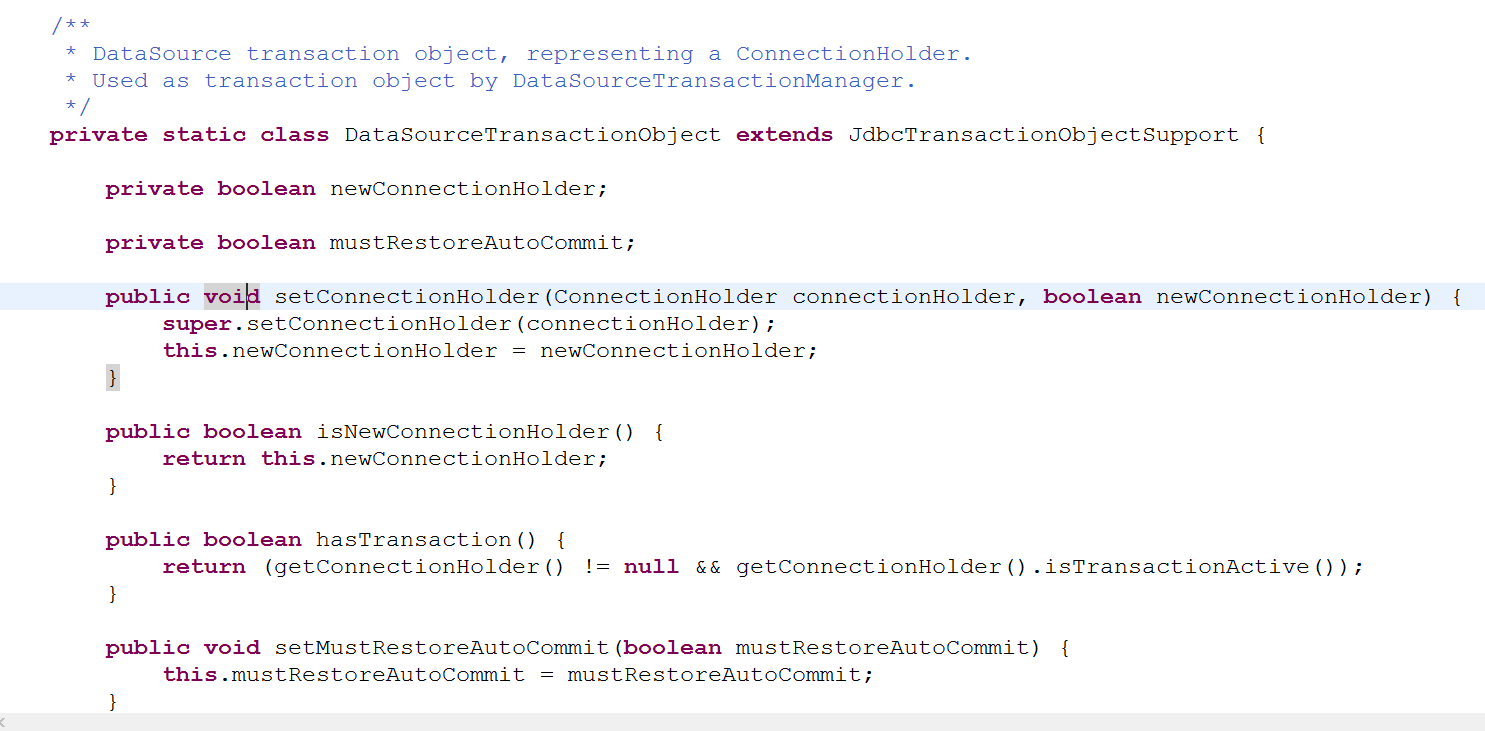
1 | DataSourceTransactionObject也是继承自JdbcTransactionObjectSupport |
1 | <br>三、回到AbstractPlatformTransactionManager类的getTransaction方法<br>进入如下代码 |

如果已经存在事务,则检查事务的传播行为
2、进入handleExistingTransaction方法
1 2 3 4 5 6 7 8 9 10 11 12 13 14 15 16 17 18 19 20 21 22 23 24 25 26 27 28 29 30 31 32 33 34 35 36 37 38 39 40 41 42 43 44 45 46 47 48 49 50 51 52 53 54 55 56 57 58 59 60 61 62 63 64 65 66 67 68 69 70 71 72 73 74 75 76 77 78 79 80 81 82 83 84 85 86 87 88 89 90 91 92 93 94 95 96 97 98 99 100 101 102 103 | /** * Create a TransactionStatus for an existing transaction. */ private TransactionStatus handleExistingTransaction( TransactionDefinition definition, Object transaction, boolean debugEnabled) throws TransactionException { if (definition.getPropagationBehavior() == TransactionDefinition.PROPAGATION_NEVER) { throw new IllegalTransactionStateException( "Existing transaction found for transaction marked with propagation 'never'"); } if (definition.getPropagationBehavior() == TransactionDefinition.PROPAGATION_NOT_SUPPORTED) { if (debugEnabled) { logger.debug("Suspending current transaction"); } Object suspendedResources = suspend(transaction); boolean newSynchronization = (getTransactionSynchronization() == SYNCHRONIZATION_ALWAYS); return prepareTransactionStatus( definition, null, false, newSynchronization, debugEnabled, suspendedResources); } if (definition.getPropagationBehavior() == TransactionDefinition.PROPAGATION_REQUIRES_NEW) { if (debugEnabled) { logger.debug("Suspending current transaction, creating new transaction with name [" + definition.getName() + "]"); } SuspendedResourcesHolder suspendedResources = suspend(transaction); try { boolean newSynchronization = (getTransactionSynchronization() != SYNCHRONIZATION_NEVER); DefaultTransactionStatus status = newTransactionStatus( definition, transaction, true, newSynchronization, debugEnabled, suspendedResources); doBegin(transaction, definition); prepareSynchronization(status, definition); return status; } catch (RuntimeException beginEx) { resumeAfterBeginException(transaction, suspendedResources, beginEx); throw beginEx; } catch (Error beginErr) { resumeAfterBeginException(transaction, suspendedResources, beginErr); throw beginErr; } } if (definition.getPropagationBehavior() == TransactionDefinition.PROPAGATION_NESTED) { if (!isNestedTransactionAllowed()) { throw new NestedTransactionNotSupportedException( "Transaction manager does not allow nested transactions by default - " + "specify 'nestedTransactionAllowed' property with value 'true'"); } if (debugEnabled) { logger.debug("Creating nested transaction with name [" + definition.getName() + "]"); } if (useSavepointForNestedTransaction()) { // Create savepoint within existing Spring-managed transaction, // through the SavepointManager API implemented by TransactionStatus. // Usually uses JDBC 3.0 savepoints. Never activates Spring synchronization. DefaultTransactionStatus status = prepareTransactionStatus(definition, transaction, false, false, debugEnabled, null); status.createAndHoldSavepoint(); return status; } else { // Nested transaction through nested begin and commit/rollback calls. // Usually only for JTA: Spring synchronization might get activated here // in case of a pre-existing JTA transaction. boolean newSynchronization = (getTransactionSynchronization() != SYNCHRONIZATION_NEVER); DefaultTransactionStatus status = newTransactionStatus( definition, transaction, true, newSynchronization, debugEnabled, null); doBegin(transaction, definition); prepareSynchronization(status, definition); return status; } } // Assumably PROPAGATION_SUPPORTS or PROPAGATION_REQUIRED. if (debugEnabled) { logger.debug("Participating in existing transaction"); } if (isValidateExistingTransaction()) { if (definition.getIsolationLevel() != TransactionDefinition.ISOLATION_DEFAULT) { Integer currentIsolationLevel = TransactionSynchronizationManager.getCurrentTransactionIsolationLevel(); if (currentIsolationLevel == null || currentIsolationLevel != definition.getIsolationLevel()) { Constants isoConstants = DefaultTransactionDefinition.constants; throw new IllegalTransactionStateException("Participating transaction with definition [" + definition + "] specifies isolation level which is incompatible with existing transaction: " + (currentIsolationLevel != null ? isoConstants.toCode(currentIsolationLevel, DefaultTransactionDefinition.PREFIX_ISOLATION) : "(unknown)")); } } if (!definition.isReadOnly()) { if (TransactionSynchronizationManager.isCurrentTransactionReadOnly()) { throw new IllegalTransactionStateException("Participating transaction with definition [" + definition + "] is not marked as read-only but existing transaction is"); } } } boolean newSynchronization = (getTransactionSynchronization() != SYNCHRONIZATION_NEVER); return prepareTransactionStatus(definition, transaction, false, newSynchronization, debugEnabled, null); } |
其中的doBegin(transaction, definition);方法,是开启事务
进入最后一行的prepareTransactionStatus方法

1 | 3、返回AbstractPlatformTransactionManager类的getTransaction方法,进入如下代码 |
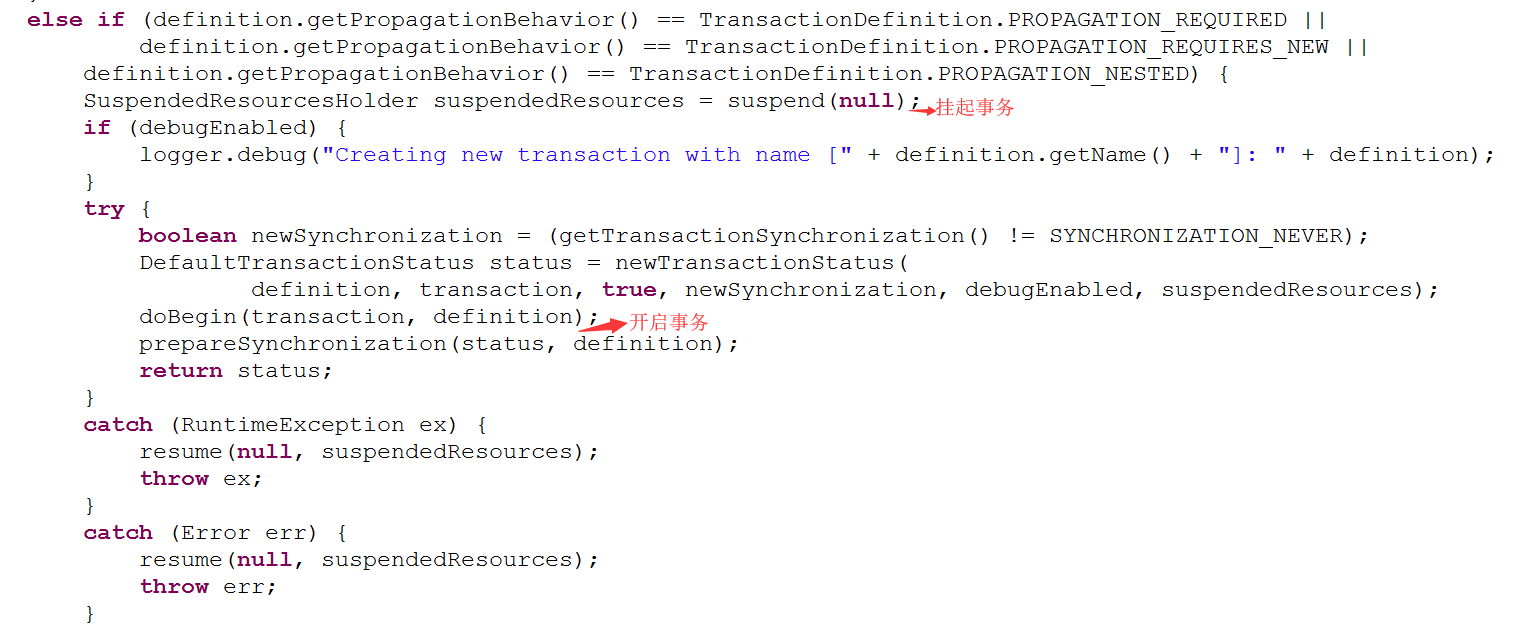
1 | 4、进入Hibernate的doBegin开启事务方法实现 |
1 2 3 4 5 6 7 8 9 10 11 12 13 14 15 16 17 18 19 20 21 22 23 24 25 26 27 28 29 30 31 32 33 34 35 36 37 38 39 40 41 42 43 44 45 46 47 48 49 50 51 52 53 54 55 56 57 58 59 60 61 62 63 64 65 66 67 68 69 70 71 72 73 74 75 76 77 78 79 80 81 82 83 84 85 86 87 88 89 90 91 92 93 94 95 96 97 98 99 100 101 102 103 104 105 106 107 108 109 110 111 112 113 114 115 116 117 118 119 120 121 122 123 124 125 | protected void doBegin(Object transaction, TransactionDefinition definition) { HibernateTransactionObject txObject = (HibernateTransactionObject) transaction; if (txObject.hasConnectionHolder() && !txObject.getConnectionHolder().isSynchronizedWithTransaction()) { throw new IllegalTransactionStateException( "Pre-bound JDBC Connection found! HibernateTransactionManager does not support " + "running within DataSourceTransactionManager if told to manage the DataSource itself. " + "It is recommended to use a single HibernateTransactionManager for all transactions " + "on a single DataSource, no matter whether Hibernate or JDBC access."); } Session session = null; try { if (txObject.getSessionHolder() == null || txObject.getSessionHolder().isSynchronizedWithTransaction()) { Interceptor entityInterceptor = getEntityInterceptor(); Session newSession = (entityInterceptor != null ? getSessionFactory().openSession(entityInterceptor) : getSessionFactory().openSession()); if (logger.isDebugEnabled()) { logger.debug("Opened new Session [" + SessionFactoryUtils.toString(newSession) + "] for Hibernate transaction"); } txObject.setSession(newSession); } session = txObject.getSessionHolder().getSession(); if (this.prepareConnection && isSameConnectionForEntireSession(session)) { // We're allowed to change the transaction settings of the JDBC Connection. if (logger.isDebugEnabled()) { logger.debug( "Preparing JDBC Connection of Hibernate Session [" + SessionFactoryUtils.toString(session) + "]"); } Connection con = session.connection(); Integer previousIsolationLevel = DataSourceUtils.prepareConnectionForTransaction(con, definition); txObject.setPreviousIsolationLevel(previousIsolationLevel); } else { // Not allowed to change the transaction settings of the JDBC Connection. if (definition.getIsolationLevel() != TransactionDefinition.ISOLATION_DEFAULT) { // We should set a specific isolation level but are not allowed to... throw new InvalidIsolationLevelException( "HibernateTransactionManager is not allowed to support custom isolation levels: " + "make sure that its 'prepareConnection' flag is on (the default) and that the " + "Hibernate connection release mode is set to 'on_close' (SpringTransactionFactory's default). " + "Make sure that your LocalSessionFactoryBean actually uses SpringTransactionFactory: Your " + "Hibernate properties should *not* include a 'hibernate.transaction.factory_class' property!"); } if (logger.isDebugEnabled()) { logger.debug( "Not preparing JDBC Connection of Hibernate Session [" + SessionFactoryUtils.toString(session) + "]"); } } if (definition.isReadOnly() && txObject.isNewSession()) { // Just set to NEVER in case of a new Session for this transaction. session.setFlushMode(FlushMode.MANUAL); } if (!definition.isReadOnly() && !txObject.isNewSession()) { // We need AUTO or COMMIT for a non-read-only transaction. FlushMode flushMode = session.getFlushMode(); if (flushMode.lessThan(FlushMode.COMMIT)) { session.setFlushMode(FlushMode.AUTO); txObject.getSessionHolder().setPreviousFlushMode(flushMode); } } Transaction hibTx; // Register transaction timeout. int timeout = determineTimeout(definition); if (timeout != TransactionDefinition.TIMEOUT_DEFAULT) { // Use Hibernate's own transaction timeout mechanism on Hibernate 3.1+ // Applies to all statements, also to inserts, updates and deletes! hibTx = session.getTransaction(); hibTx.setTimeout(timeout); hibTx.begin(); } else { // Open a plain Hibernate transaction without specified timeout. hibTx = session.beginTransaction(); } // Add the Hibernate transaction to the session holder. txObject.getSessionHolder().setTransaction(hibTx); // Register the Hibernate Session's JDBC Connection for the DataSource, if set. if (getDataSource() != null) { Connection con = session.connection(); ConnectionHolder conHolder = new ConnectionHolder(con); if (timeout != TransactionDefinition.TIMEOUT_DEFAULT) { conHolder.setTimeoutInSeconds(timeout); } if (logger.isDebugEnabled()) { logger.debug("Exposing Hibernate transaction as JDBC transaction [" + con + "]"); } TransactionSynchronizationManager.bindResource(getDataSource(), conHolder); txObject.setConnectionHolder(conHolder); } // Bind the session holder to the thread. if (txObject.isNewSessionHolder()) { TransactionSynchronizationManager.bindResource(getSessionFactory(), txObject.getSessionHolder()); } txObject.getSessionHolder().setSynchronizedWithTransaction(true); } catch (Exception ex) { if (txObject.isNewSession()) { try { if (session.getTransaction().isActive()) { session.getTransaction().rollback(); } } catch (Throwable ex2) { logger.debug("Could not rollback Session after failed transaction begin", ex); } finally { SessionFactoryUtils.closeSession(session); } } throw new CannotCreateTransactionException("Could not open Hibernate Session for transaction", ex); } } |
关键代码
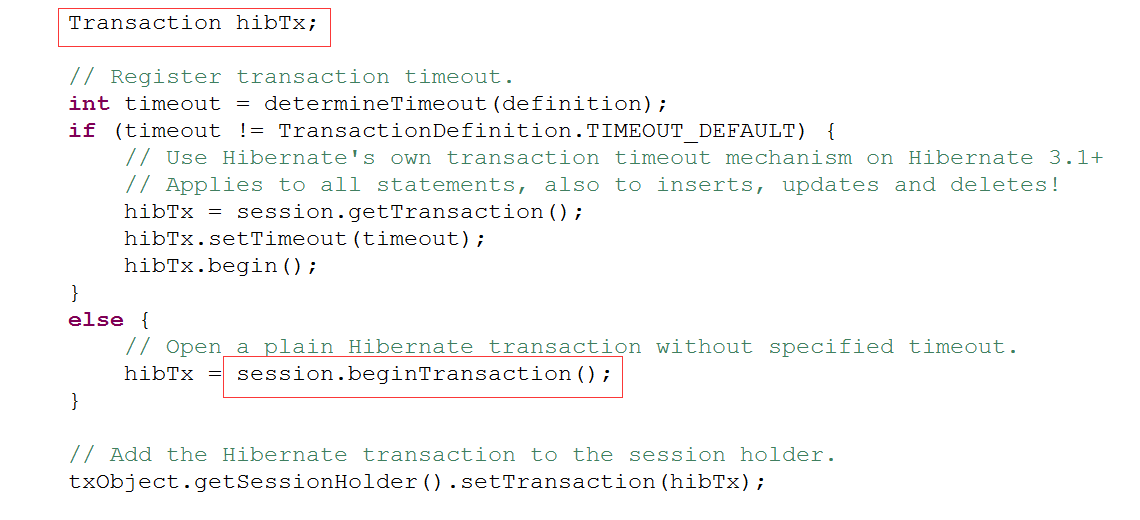
1 | <br>5、进入JDBC的doBegin方法实现方式(DataSourceTransactionManager类中) |
1 2 3 4 5 6 7 8 9 10 11 12 13 14 15 16 17 18 19 20 21 22 23 24 25 26 27 28 29 30 31 32 33 34 35 36 37 38 39 40 41 42 43 44 45 46 47 48 49 | @Override protected void doBegin(Object transaction, TransactionDefinition definition) { DataSourceTransactionObject txObject = (DataSourceTransactionObject) transaction; Connection con = null; try { if (txObject.getConnectionHolder() == null || txObject.getConnectionHolder().isSynchronizedWithTransaction()) { Connection newCon = this.dataSource.getConnection(); if (logger.isDebugEnabled()) { logger.debug("Acquired Connection [" + newCon + "] for JDBC transaction"); } txObject.setConnectionHolder(new ConnectionHolder(newCon), true); } txObject.getConnectionHolder().setSynchronizedWithTransaction(true); con = txObject.getConnectionHolder().getConnection(); Integer previousIsolationLevel = DataSourceUtils.prepareConnectionForTransaction(con, definition); txObject.setPreviousIsolationLevel(previousIsolationLevel); // Switch to manual commit if necessary. This is very expensive in some JDBC drivers, // so we don't want to do it unnecessarily (for example if we've explicitly // configured the connection pool to set it already). if (con.getAutoCommit()) { txObject.setMustRestoreAutoCommit(true); if (logger.isDebugEnabled()) { logger.debug("Switching JDBC Connection [" + con + "] to manual commit"); } con.setAutoCommit(false); } txObject.getConnectionHolder().setTransactionActive(true); int timeout = determineTimeout(definition); if (timeout != TransactionDefinition.TIMEOUT_DEFAULT) { txObject.getConnectionHolder().setTimeoutInSeconds(timeout); } // Bind the session holder to the thread. if (txObject.isNewConnectionHolder()) { TransactionSynchronizationManager.bindResource(getDataSource(), txObject.getConnectionHolder()); } } catch (Exception ex) { DataSourceUtils.releaseConnection(con, this.dataSource); throw new CannotCreateTransactionException("Could not open JDBC Connection for transaction", ex); } } |
开启事务: con.setAutoCommit(false);,关闭自动提交,换句话说就是手工提交,开启了事务。
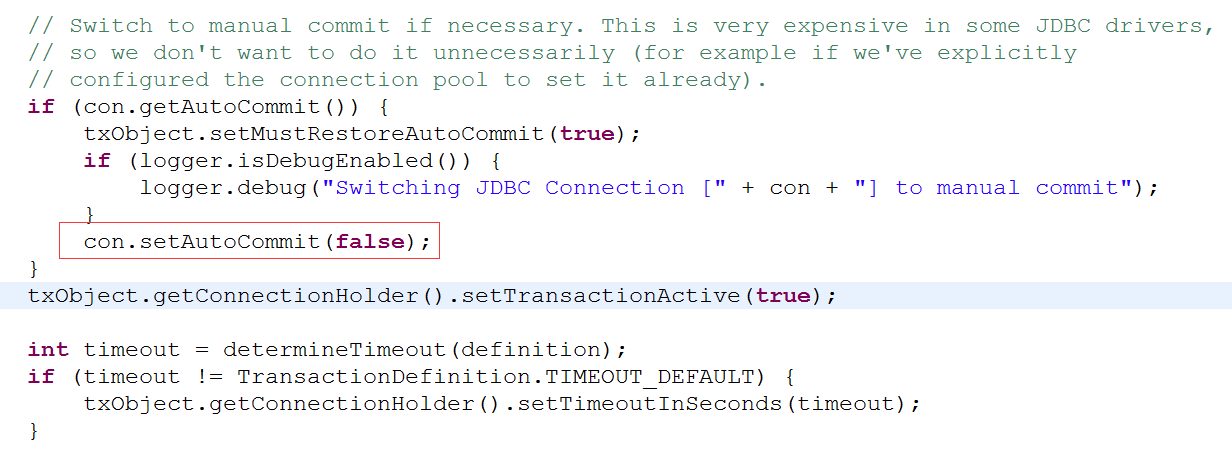
6、返回TransactionAspectSupport类createTransactionIfNecessary方法
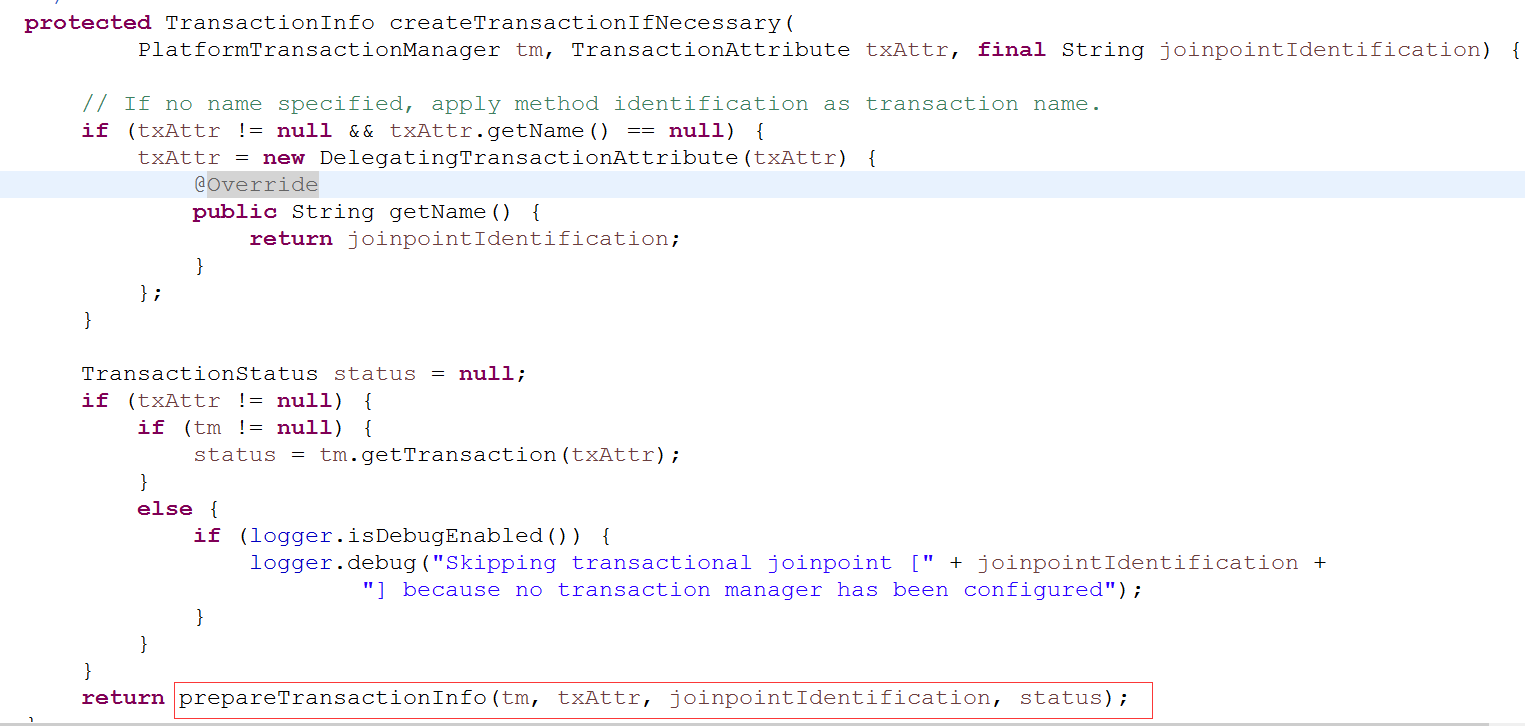
进入prepareTransactionInfo方法
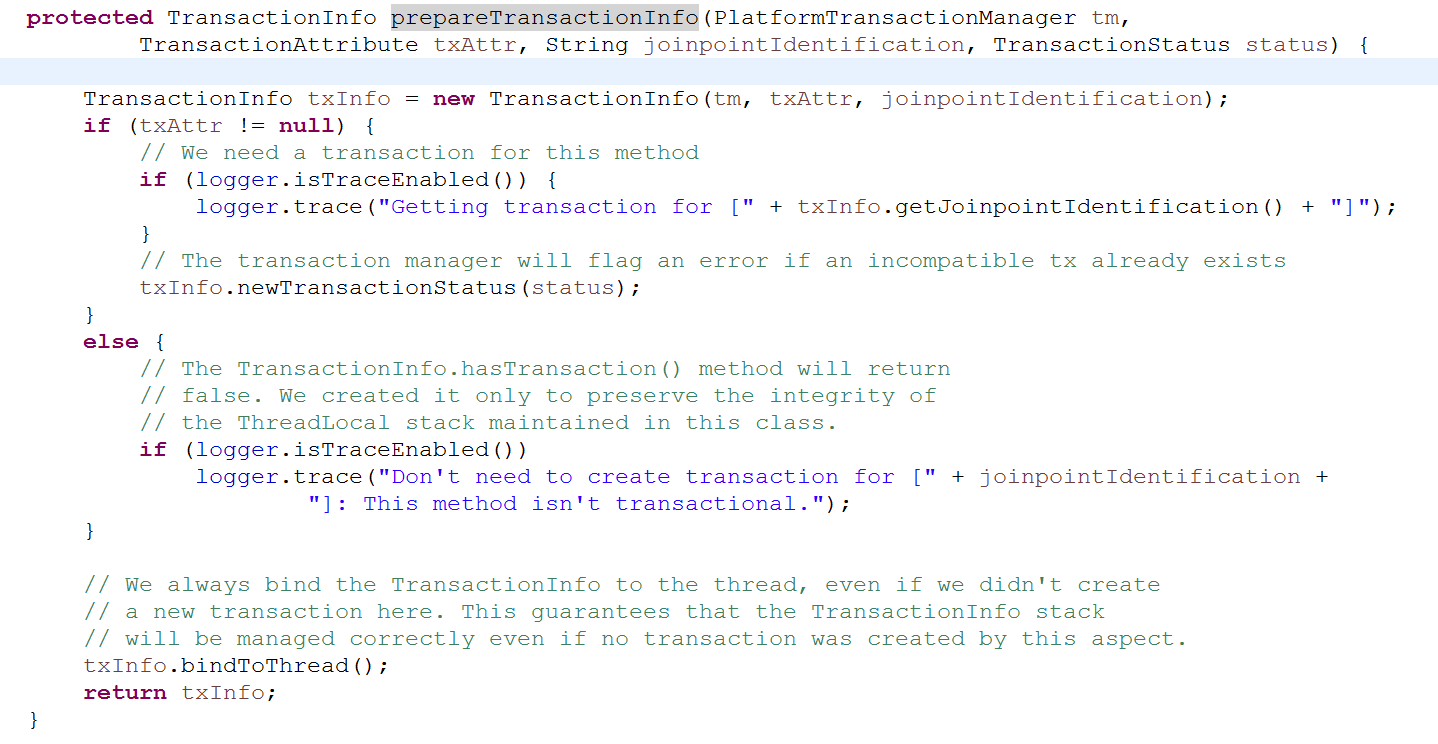
7、定位到txInfo.bindToThread();
进入bindToThread方法

公开当前的TransactionStatus,当前事务完成之后,恢复之前的事务。 我们可以理解成,如果存在嵌套事务,将外层事务保存在oldTransactionInfo里面,里面的事务执行完成后再获取外层的。实际上就是将外层的事务挂起。
8、回到TransactionInterceptor类的invoke方法
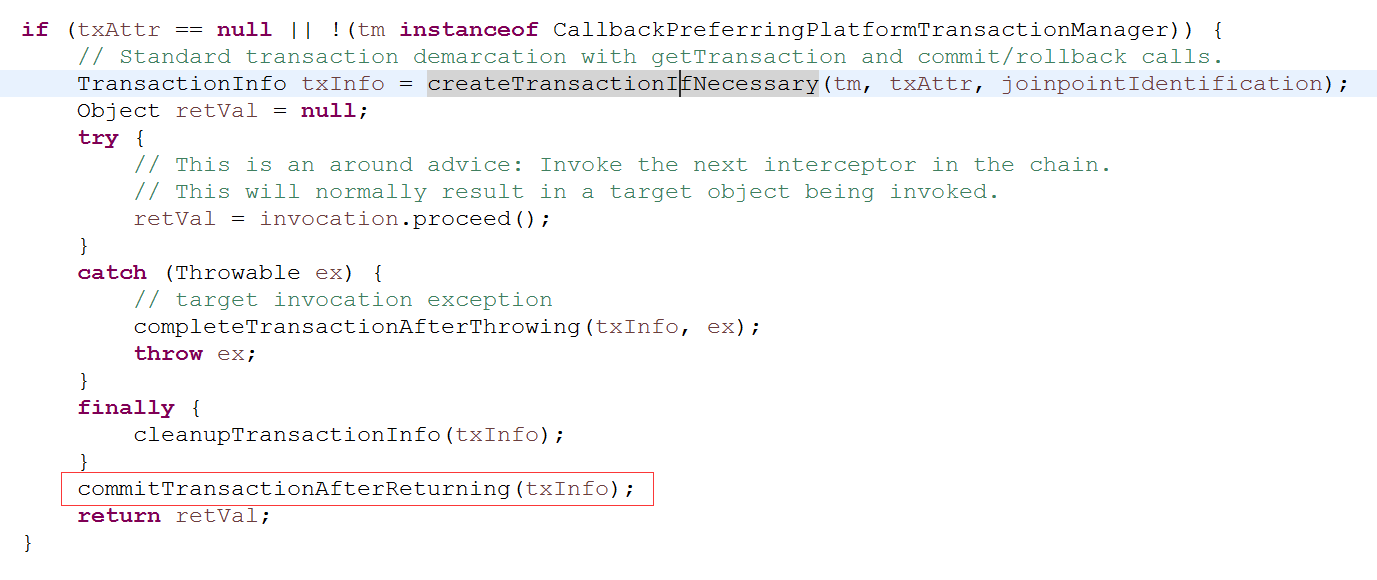
commitTransactionAfterReturning 最终提交事务。
进入commitTransactionAfterReturning 方法

进入txInfo.getTransactionManager().commit(txInfo.getTransactionStatus()); 方法的实现
1 2 3 4 5 6 7 8 9 10 11 12 13 14 15 16 17 18 19 20 21 22 23 24 25 26 27 28 29 30 31 32 33 34 35 36 37 38 39 | /** * This implementation of commit handles participating in existing * transactions and programmatic rollback requests. * Delegates to <code>isRollbackOnly</code>, <code>doCommit</code> * and <code>rollback</code>. * @see org.springframework.transaction.TransactionStatus#isRollbackOnly() * @see #doCommit * @see #rollback */public final void commit(TransactionStatus status) throws TransactionException { if (status.isCompleted()) { throw new IllegalTransactionStateException( "Transaction is already completed - do not call commit or rollback more than once per transaction"); } DefaultTransactionStatus defStatus = (DefaultTransactionStatus) status; if (defStatus.isLocalRollbackOnly()) { if (defStatus.isDebug()) { logger.debug("Transactional code has requested rollback"); } processRollback(defStatus); return; } if (!shouldCommitOnGlobalRollbackOnly() && defStatus.isGlobalRollbackOnly()) { if (defStatus.isDebug()) { logger.debug("Global transaction is marked as rollback-only but transactional code requested commit"); } processRollback(defStatus); // Throw UnexpectedRollbackException only at outermost transaction boundary // or if explicitly asked to. if (status.isNewTransaction() || isFailEarlyOnGlobalRollbackOnly()) { throw new UnexpectedRollbackException( "Transaction rolled back because it has been marked as rollback-only"); } return; } processCommit(defStatus);} |
进入最后一行processCommit(defStatus);
1 2 3 4 5 6 7 8 9 10 11 12 13 14 15 16 17 18 19 20 21 22 23 24 25 26 27 28 29 30 31 32 33 34 35 36 37 38 39 40 41 42 43 44 45 46 47 48 49 50 51 52 53 54 55 56 57 58 59 60 61 62 63 64 65 66 67 68 69 70 71 72 73 74 75 76 77 78 79 80 81 | /** * Process an actual commit. * Rollback-only flags have already been checked and applied. * @param status object representing the transaction * @throws TransactionException in case of commit failure */private void processCommit(DefaultTransactionStatus status) throws TransactionException { try { boolean beforeCompletionInvoked = false; try { prepareForCommit(status); triggerBeforeCommit(status); triggerBeforeCompletion(status); beforeCompletionInvoked = true; boolean globalRollbackOnly = false; if (status.isNewTransaction() || isFailEarlyOnGlobalRollbackOnly()) { globalRollbackOnly = status.isGlobalRollbackOnly(); } if (status.hasSavepoint()) { if (status.isDebug()) { logger.debug("Releasing transaction savepoint"); } status.releaseHeldSavepoint(); } else if (status.isNewTransaction()) { if (status.isDebug()) { logger.debug("Initiating transaction commit"); } doCommit(status); } // Throw UnexpectedRollbackException if we have a global rollback-only // marker but still didn't get a corresponding exception from commit. if (globalRollbackOnly) { throw new UnexpectedRollbackException( "Transaction silently rolled back because it has been marked as rollback-only"); } } catch (UnexpectedRollbackException ex) { // can only be caused by doCommit triggerAfterCompletion(status, TransactionSynchronization.STATUS_ROLLED_BACK); throw ex; } catch (TransactionException ex) { // can only be caused by doCommit if (isRollbackOnCommitFailure()) { doRollbackOnCommitException(status, ex); } else { triggerAfterCompletion(status, TransactionSynchronization.STATUS_UNKNOWN); } throw ex; } catch (RuntimeException ex) { if (!beforeCompletionInvoked) { triggerBeforeCompletion(status); } doRollbackOnCommitException(status, ex); throw ex; } catch (Error err) { if (!beforeCompletionInvoked) { triggerBeforeCompletion(status); } doRollbackOnCommitException(status, err); throw err; } // Trigger afterCommit callbacks, with an exception thrown there // propagated to callers but the transaction still considered as committed. try { triggerAfterCommit(status); } finally { triggerAfterCompletion(status, TransactionSynchronization.STATUS_COMMITTED); } } finally { cleanupAfterCompletion(status); }} |
真正提交事务的方法

doCommit是一个抽象类,由具体的子类实现
9、进入Hibernate的doCommit实现
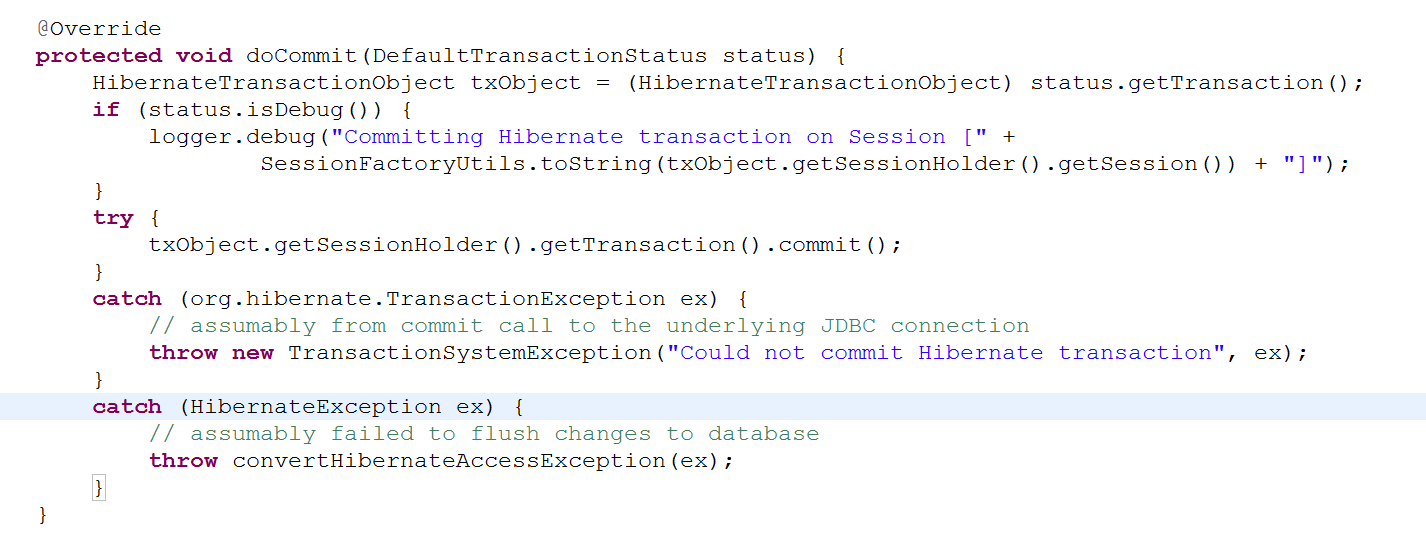
10.进入JDBC实现的doCommit实现

11、回到TransactionInterceptor类的invoke方法,定位到抛出异常代码completeTransactionAfterThrowing(txInfo, ex);
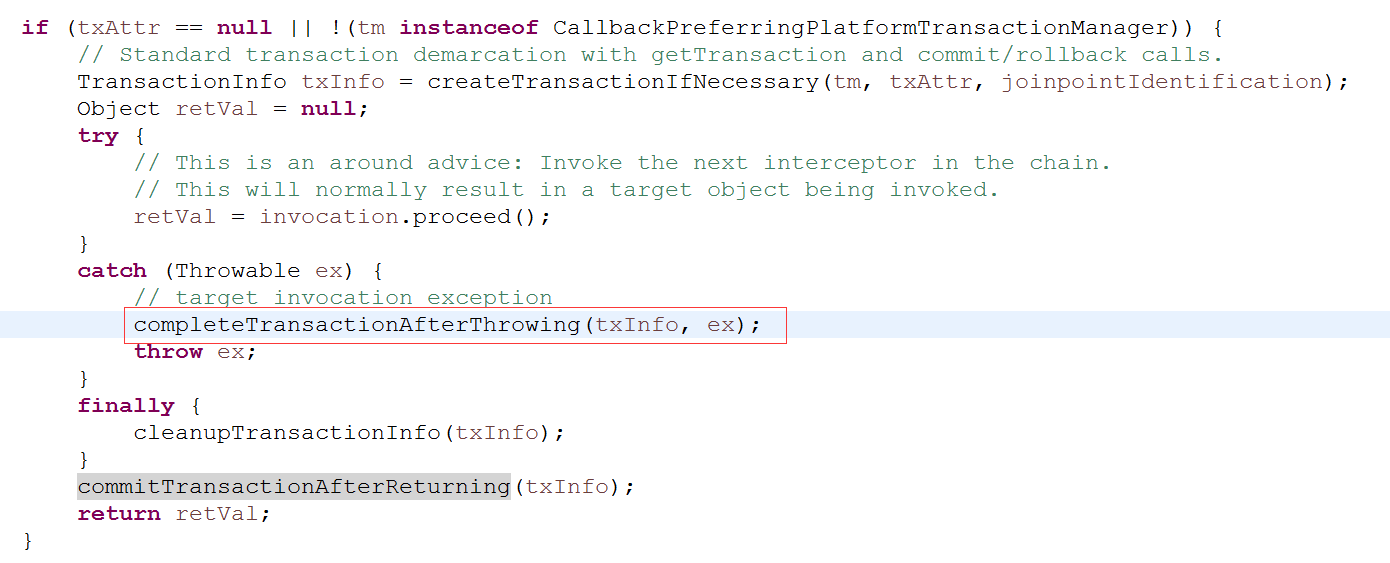
进入completeTransactionAfterThrowing(txInfo, ex);方法
1 2 3 4 5 6 7 8 9 10 11 12 13 14 15 16 17 18 19 20 21 22 23 24 25 26 27 28 29 30 31 32 33 34 35 36 37 38 39 40 41 42 43 44 45 46 47 48 49 50 51 52 | /** * Handle a throwable, completing the transaction. * We may commit or roll back, depending on the configuration. * @param txInfo information about the current transaction * @param ex throwable encountered */ protected void completeTransactionAfterThrowing(TransactionInfo txInfo, Throwable ex) { if (txInfo != null && txInfo.hasTransaction()) { if (logger.isTraceEnabled()) { logger.trace("Completing transaction for [" + txInfo.getJoinpointIdentification() + "] after exception: " + ex); } if (txInfo.transactionAttribute.rollbackOn(ex)) { try { txInfo.getTransactionManager().rollback(txInfo.getTransactionStatus()); } catch (TransactionSystemException ex2) { logger.error("Application exception overridden by rollback exception", ex); ex2.initApplicationException(ex); throw ex2; } catch (RuntimeException ex2) { logger.error("Application exception overridden by rollback exception", ex); throw ex2; } catch (Error err) { logger.error("Application exception overridden by rollback error", ex); throw err; } } else { // We don't roll back on this exception. // Will still roll back if TransactionStatus.isRollbackOnly() is true. try { txInfo.getTransactionManager().commit(txInfo.getTransactionStatus()); } catch (TransactionSystemException ex2) { logger.error("Application exception overridden by commit exception", ex); ex2.initApplicationException(ex); throw ex2; } catch (RuntimeException ex2) { logger.error("Application exception overridden by commit exception", ex); throw ex2; } catch (Error err) { logger.error("Application exception overridden by commit error", ex); throw err; } } } } |
根据当前事务的配置,来确定是提交还是回滚。
12、回到TransactionInterceptor类的invoke方法,定位到cleanupTransactionInfo(txInfo);方法
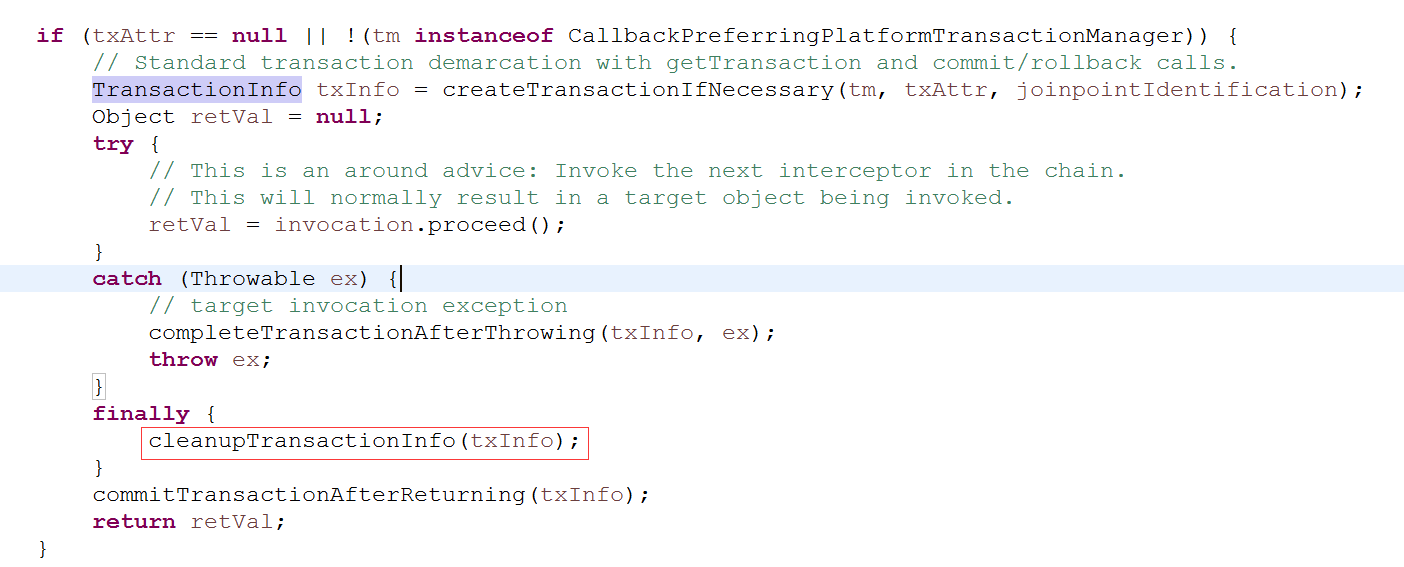
进入cleanupTransactionInfo方法
重置TransactionInfo ThreadLocal
1 2 3 4 5 6 7 8 9 10 | /** * Reset the TransactionInfo ThreadLocal. * <p>Call this in all cases: exception or normal return! * @param txInfo information about the current transaction (may be <code>null</code>) */protected void cleanupTransactionInfo(TransactionInfo txInfo) { if (txInfo != null) { txInfo.restoreThreadLocalStatus(); }} |
进入restoreThreadLocalStatus方法

相当于里层的事务执行完了,恢复外层的事务

transactionInfoHolder是一个ThreadLocal类型的变量。
总结,Spring事务用到的几个类
TransactionDefinition 事务的定义,下面有一个重要的子接口TransactionAttribute,主要描述事务的配置信息
TransactionInfo 是一个内部类,里面包含了TransactionStatus和自身TransactionInfo (用于嵌套事务,供恢复使用)

TransactionStatus: 当前事务运行期的一些状态。
PlatformTransactionManager: 平台事务管理器
AbstractPlatformTransactionManager 抽象平台事务管理器的实现类,里面用到了大量的模板方法(模板方法设计模式)
AbstractPlatformTransactionManager 抽象平台事务管理器下面,就是各个平台相关的事务管理器。如下图:
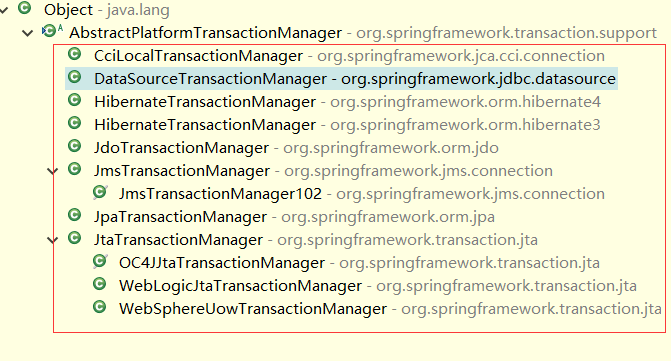
作者:Work Hard Work Smart
出处:http://www.cnblogs.com/linlf03/
欢迎任何形式的转载,未经作者同意,请保留此段声明!



【推荐】还在用 ECharts 开发大屏?试试这款永久免费的开源 BI 工具!
【推荐】国内首个AI IDE,深度理解中文开发场景,立即下载体验Trae
【推荐】编程新体验,更懂你的AI,立即体验豆包MarsCode编程助手
【推荐】轻量又高性能的 SSH 工具 IShell:AI 加持,快人一步